Quantitative Aptitude
Ratio & Proportion
Explore formulas, problem-solving techniques, examples, and real-life applications to improve your skills and ace competitive exams.
When it comes to quantitative aptitude, Ratio and Proportion is a fundamental topic that frequently appears in exams. This topic not only helps in cracking competitive exams but also enhances one’s problem-solving and reasoning skills in everyday scenarios. Understanding ratios and proportions can give you an edge in tests and even help in managing real-life situations like budgeting and scaling recipes.

Ratio
Introduction to Ratio
The concept of ratio helps us to compare two or more quantities. When we say “ratio,” we’re talking about how many times one quantity is in comparison to another. This is a very useful concept, especially when we want to express a relationship between quantities in an understandable format. A ratio is defined as the quantitative relationship between two numbers, showing how many times one value contains or is contained within the other. Ratios must compare quantities of the same kind—like comparing weights with weights, lengths with lengths, etc. Ratios do not mix different units like comparing kilograms to liters; such comparisons aren’t possible without additional steps (like finding density).
How Ratios are Expressed
Ratios can be written in two primary ways:
- Using a colon, such as a:b, which reads as “a to b.”
- As a fraction, a/b, which means the value of “a” per “b.”
For instance, if there are 10 apples and 5 oranges, and we want to express the relationship of apples to oranges, the ratio would be:
10:5
To simplify this, we divide both terms by their greatest common divisor, which is 5:
10:5=2:1
So, the simplified ratio of apples to oranges is 2 : 1, meaning that for every two apples, there is one orange.
Formula
The formula for calculating a ratio between two quantities a and b is:
a:b or a/b
Suppose there are 15 blue marbles and 10 red marbles. To find the ratio of blue to red marbles:
Example Problem
- Write the initial ratio as 15:10.
- Simplify by dividing both numbers by their greatest common divisor, which is 5:
15:10=3:2
So, the ratio of blue marbles to red marbles is 3 : 2, meaning there are 3 blue marbles for every 2 red ones.
Introduction to Proportion
While a ratio compares two quantities, a proportion is an equation that states that two ratios are equivalent. Proportion is a crucial concept when dealing with quantities that need to maintain a certain relationship.
Definition
A proportion states that two ratios are equal. If a:b=c:d, then we say a, b, c, and d are in proportion. The notation can be written as a:b :: c:d
This can also be expressed as a fraction: a/b=c/d

Proportion
Properties of Proportion
A proportion is an equation that shows two ratios are equal, meaning two fractions or ratios are equivalent. When two sets of numbers increase or decrease at the same rate, they are considered directly proportional to each other.
In a proportion, the product of the means is equal to the product of the extremes. The “means” are the inner terms b and c, and the “extremes” are the outer terms a and d. Therefore, if a:b=c:d, then:
a⋅d=b⋅c
Example Problem
Imagine that in a recipe, the ratio of sugar to flour is 2 : 3. If we want to make a larger batch of the recipe that uses 6 cups of flour, we can use proportions to determine how much sugar is needed:
Set up the proportion: 2 : 3 = x : 6
Convert to an equation using cross-multiplication: 2⋅6=3⋅x
Simplify= (12 = 3x)
x=4
Properties of Proportion
Addendo: If a : b = c : d, then a + c : b + d
Explanation: This property states that if two ratios are equal, then adding the corresponding terms in the ratios will also yield an equivalent ratio. For example, if a:b is proportional to c:d, then adding a to c and b to d will result in a new ratio (a+c):(b+d) that is also in proportion.
Subtrahendo: If a : b = c : d, then a – c : b – d
Explanation: This property means that if two ratios are equal, subtracting the corresponding terms in these ratios will also yield an equivalent ratio. For instance, if a:b=c:d, then (a−c):(b−d) will be a proportional relationship as well.
Dividendo: If a : b = c : d, then a – b : b = c – d : d
Explanation: In this property, if two ratios are equivalent, then subtracting the second term from the first term in each ratio and comparing it to the original second term will produce another equivalent ratio. So, (a−b):b is proportional to (c−d):d.
Componendo: If a : b = c : d, then a + b : b = c+d : d
Explanation: This property implies that if two ratios are in proportion, adding each ratio’s terms (numerator and denominator) and comparing it with the original denominator results in another proportion. Therefore, (a+b):b will be proportional to (c+d):d.
Alternendo: If a : b = c : d, then a : c = b: d
Explanation: This property indicates that if two ratios are in proportion, then we can interchange the means (the middle terms) to create a new proportion. So, if a:b=c:d, you can rewrite this as a:c=b:d.
Invertendo: If a : b = c : d, then b : a = d : c
Explanation: This property states that if two ratios are proportional, taking the reciprocal of each ratio will also yield an equivalent proportion. This means b:a will be in proportion to d:c.
Componendo and Dividendo: If a : b = c : d, then a + b : a – b = c + d : c – d
This combined property involves both adding and subtracting the terms of each ratio. It means that if two ratios are equal, then the ratio of the sum of terms to the difference of terms in each ratio will also be proportional. So, (a+b):(a−b) will be equivalent to (c+d):(c−d).
Types of Ratios
Different types of ratios help in different situations. Here are some common types:
Duplicate Ratio
The duplicate ratio of a:b is a2:b2. It essentially squares both terms. Example: If we have 2:3, the duplicate ratio would be: 22:32 = 4:9.
Triplicate Ratio
The triplicate ratio of a:b is a3:b3, meaning each term is cubed. Example: For 2:3, the triplicate ratio would be: 23 : 33 = 8:27
Sub-Duplicate Ratio
The sub-duplicate ratio involves taking the square root of both terms. For a:b, the sub-duplicate ratio is √a:√b. Example: For 9:16, the sub-duplicate ratio is: √9:√16 = 3 : 4
Inverse Ratio
The inverse ratio flips the terms. For a:b, the inverse ratio is b:a. Example: If the original ratio is 3:4, the inverse ratio is 4:3.
Types of Proportions
Proportions can come in various forms depending on the relationship between the quantities.
Direct Proportion
Two quantities are in direct proportion if increasing one increases the other by the same factor. This is represented a:b=c:d
where an increase in a results in a proportional increase in c, provided b and d are constants.
Example: Distance and time are directly proportional if speed is constant. If you travel at a constant speed, doubling the time will double the distance traveled.
Inverse Proportion
Two quantities are in inverse proportion if an increase in one results in a proportional decrease in the other. For example, speed and travel time are inversely proportional; if you increase your speed, the travel time decreases proportionally.
Ratio & Proportion Mastery Challenge
Challenge yourself with this three-stage quiz on Ratio and Proportion, crafted to enhance your problem-solving skills step by step!
Conclusion
Ratio and Proportion is an essential topic that forms the foundation for many concepts in mathematics and quantitative aptitude. By understanding ratios, we can compare different quantities effectively, and with proportions, we solve problems that involve equal relationships between ratios. Mastering the basic rules and practicing different types of problems is key to success in this topic. Whether it’s for exams or real-life applications, a strong command of ratios and proportions can prove invaluable.

Leave a Reply